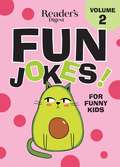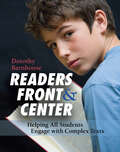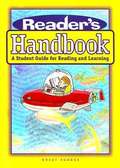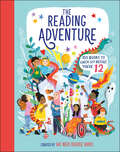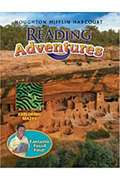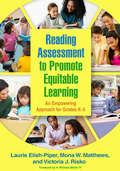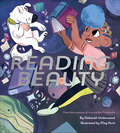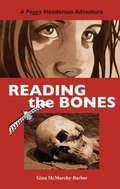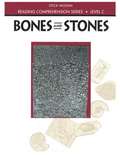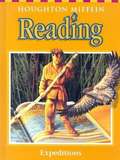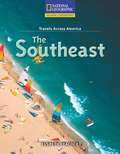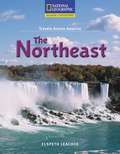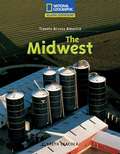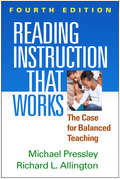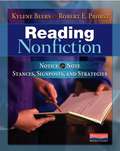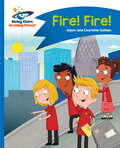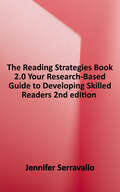- Table View
- List View
Reader's Digest Fun Jokes for Funny Kids Vol. 2
by Reader'S DigestWhy aren't dogs good dancers?... ...They have two left feet! Do you have a budding comedian on your hands? Loaded with Knock Knock jokes, riddles, one-liners, tongue twisters and puns, Fun Jokes for Funny Kids Vol. 2 will give them hours of new material that will keep kids ages 6-12 rolling in laughter.Knock Knock jokes, riddles, tongue twisters, one-liners and puns guaranteed to make your kids (and you) laugh out loud. Plus--Icon for Alexa's Favorites. Alexa is a 2nd grader from New York who loves telling jokes. She has hand-picked her favorites from each chapter. Knock Knock. ...Who's there? Dozen. ...Dozen who? Dozen anyone want to let me in? Knock Knock. ...Who's there? Pecan. ...Pecan who? Pecan someone you're own size! Why don't mummies take time off? ...They are afraid to unwind! Did you hear about the crook that stole a calendar? ...He got 12 months! What would bears be without bees? ...Ears! What travels all over the world but stays in one corner? A Stamp! How do turtles talk to each other? By using shell phones! Why are ghosts bad liars? Because you can see right through them! Why did the spider go to the computer? To check his web site. Where do polar bears vote? The North Poll.
Readers Front and Center: Helping All Students Engage with Complex Text
by Dorothy BarnhouseEvery teacher wants and expects his or her students to be reading increasingly complex texts, yet sometimes the gap between our expectations and our students' abilities seems wide and deep. It's tempting to look at that gap and step in to fill it for them, but then we'd be doing most of the heavy lifting the understanding, analysis, and interpretation that our students should be learning for themselves. So how can teachers reverse this trend and ensure that our students are fully entering, absorbing, and experiencing texts? How can we make sure they're making complex meaning independently and proficiently,- as the Common Core State Standards require? Readers Front & Center answers these questions by framing instruction that starts with the student. You'll learn how to do the following: Research and listen to your students so your teaching can be more targetedNotice and name your students' thinking so they can see- what complex thinking looks and sounds likeSet your students up to be problem solversPrepare your students to do increasingly complex thinking in increasingly complex texts Filled with examples of one-on-one conferences, small groups, and whole-class scenarios, this essential book provides an accessible and inspiring model of how-;and why-;we need to put students at the front and center of our teaching.
Reader's Handbook, A Student Guide for Reading and Learning
by Laura Robb Margaret Ann Richek Vicki Spandel Mike Mcconnell Phil Laleike- In-depth understanding of the Before, During, and After reading process- Essential skills and strategies for a variety of materials and genres- Key comprehension tools, including notetaking, outlining, cause-effect diagrams, and double-entry journals- A resource for content area reading, supplemental reading activities, tutorials, and homework support
Reading 4 Christian Schools: I Met You In A Story (Second Edition)
by Dorothy BuckleyStories, poetry and folktales from around the world.
The Reading Adventure: 100 Books to Check Out Before You're 12
by We Need Diverse Books DKDiscover your next read with this carefully curated list from We Need Diverse Books. Check out 100 must-read books to try before you're 12! Packed with reviews, recommendations, and exclusive author interviews, The Reading Adventure: 100 Books To Check Out Before You're 12 will inspire young readers to discover a diverse range of books beyond the curriculum. From mystery to autobiography, the book is organised by genre, so you can jump to the section that interests you the most. Each entry has a key theme box so you can immediately see if the book is something you'll enjoy. Helpful signposts lead readers to another book the author thinks they'll enjoy. Hidden gems, award-winners, classics, and current bestsellers are brought to life by vibrant illustrations. There's truly something for everyone!Vibrant and educational, you can explore:- 15 exclusive author interviews, including Jason Reynolds, Meg Medina and Linda Sue Park.- Organized by genre and theme, so the reader can find a book based on their interests.- Discover 100 book recommendations aimed at 7-12 year olds with vibrant and fun illustrations.- Running categories organized by interest and theme.- Endmatter includes writing activities, and an index.- Bold original illustrations by a range of artists bring the books to life.Developed in collaboration with We Need Diverse Books - a non-profit with a mission to create a world where everyone can find themselves in the pages of a book - young readers can explore a variety of awe-inspiring and thought-provoking books, with titles including: High Rise Mystery by Sharna Jackson, A Kind of Spark, by Elle McNicoll, From The Mixed Up Files of Mrs Basil E Frankweiler by E.L. Konigsburg, Front Desk by Kelly Yang, and many more. Ideal for caregivers and gift givers of both voracious and reluctant readers within the 7-12 age group, as well as caregivers of neurodivergent children, children with a disability, and children of color seeking greater representation in literature.
Reading Adventures [Grade 5]
by Houghton Mifflin Harcourt Publishing Company StaffNIMAC-sourced textbook
Reading Adventures [Student Magazine, Grade 5]: A National Symbol Saved; Find Your Way Home
by Houghton Mifflin Harcourt Publishing Company StaffNIMAC-sourced textbook
Reading Assessment to Promote Equitable Learning: An Empowering Approach for Grades K-5
by Laurie Elish-Piper Mona W. Matthews Victoria J. RiskoMany standard reading assessment approaches fail to capture the strengths and needs of students from diverse sociocultural, linguistic, and academic backgrounds. From expert authors, this book guides educators in planning and conducting meaningful, equitable assessments that empower K–5 teachers and students, inform responsive instruction, and help to guard against bias. The book's holistic view of reading encompasses areas from text comprehension and constrained skills to building trusting relationships and promoting students&’ agency. Twenty-eight assessment strategies are explained in step-by-step detail, including helpful implementation examples and 32 reproducible forms that teachers can download and print in a convenient 8 1/2" x 11" size.
Reading Beauty
by Deborah Underwood&“This modern retake on &“Sleeping Beauty&” is an interstellar fairy tale that is vibrantly illustrated and fun to read–aloud&” (School Library Journal).An irrepressible fairy tale retelling that is sure to charm readers of all ages: When a fairy&’s curse—a deathlike sleep via paper cut—threatens to make her kingdom barren of books, it&’s up to space princess Lex to break the spell and bring books back to her people. Set in the universe of the acclaimed Interstellar Cinderella, this empowering bedtime story for girls will entice young readers with its brave heroine, star-studded setting, and hilarious, heartwarming happy ending. Fans of Grown-Ups Never Do That and A Girl, a Racoon, and the Midnight Moon will also enjoy the fantastical storyline and captivating imagery found in Reading Beauty.Praise for Reading Beauty&“The rhyming text cleverly spins the story to involve reading at every turn. [And,] Hunt&’s mixed-media illustrations incorporate eye-pleasing sci-fi details.&” —Horn Book &“A nifty addition to the shelves of feminist fractured fairy tales.&” —Kirkus Reviews
Reading The Bones
by Gina Mcmurchy-BarberShort-listed for the 2009 Silver Birch Award, commended for the 2009 Best Books for Kids & Teens Due to circumstances beyond her control, 12-year-old Peggy Henderson has to move to the quiet town of Crescent Beach, British Columbia, to live with her aunt and uncle. Without a father and separated from her mother, who's looking for work, Peggy feels her unhappiness increasing until the day she and her uncle start digging a pond in the backyard and she realizes the rock she's been trying to pry from the ground is really a human skull. Peggy eventually learns that her home and the entire seaside town were built on top of a 5000-year-old Coast Salish fishing village. With the help of an elderly archaeologist, a woman named Eddy, Peggy comes to know the ancient storyteller buried in her yard in a way that few others can - by reading the bones. As life with her aunt becomes more and more unbearable, Peggy looks to the old Salish man from the past for help and answers.
Reading Comprehension Series-Level C: Bones and Stones
by Martha K. Resnick Carolyn J. HyattConcentrates on sequentially building vocabulary and comprehension skills.
Reading Expeditions
by J. David Cooper John J. PikulskiThis book combines poems, stories, plays, personal essays, and articles that add new perspectives on the theme or subject matter of the longer work.
Reading Expeditions: The Southeast
by Linda HoytThis guided tour helps students explore the Southeast, which includes the states of Kentucky, West Virginia, Virginia, Tennessee, North Carolina, South Carolina, Georgia, Alabama, Mississippi, Louisiana, Arkansas, and Florida. Students begin the tour looking at land and water features of the region--the Mississippi River and its delta, the Piedmont, Appalachian Mountains, and the coastal plains.
Reading Expeditions: The Northeast
by Linda HoytThe Northeast region of the United States includes Maryland, Delaware, New Jersey, Pennsylvania, New York, Connecticut, Rhode Island, Massachusetts, Vermont, New Hampshire, Maine, and the District of Columbia. Land features of the Northeast region include coastal plains, rocky coastlines, and mountains. The Northeast economy depends heavily on the region's natural resources. Industries include shipping, timber, fishing, manufacturing, and tourism. Tourists to the Northeast region come to hike, swim, ski, camp, and to visit many historical and cultural sights, including the many Smithsonian museums in Washington, D.C.
Reading Expeditions: The Midwest
by Linda HoytThe Midwestern region of the United States includes Minnesota, Wisconsin, Michigan, Nebraska, Ohio, Indiana, Illinois, Missouri, Iowa, Kansas, South Dakota, and North Dakota. Readers learn why the Midwest is flat and familiarize themselves with other features of the landscape as they tour the Great Lakes, the Ohio and Missouri Rivers, the Great Plains, the Badlands, and Wind and Jewel Caves. Students learn that the economy of the Midwest consists of "belts" from the Corn Belt to the Dairy Belt to the Manufacturing Belt.
Reading for Christian Schools 5
by Bju StaffA book that helps students build their reading and thinking skills by use of literature materials provided.
Reading for Detail Reading Comprehension Book Reading: Level 3.5 - 5.0
by EdupressWelcome to the Edupress Reading for Detail Reading Comprehension Book. This resource is an effective tool for instruction, practice, and evaluation of student understanding. It includes ideas on how to introduce reading for detail to students, as well as activities to help teach and practice the concept.
Reading Instruction That Works, Fourth Edition: The Case for Balanced Teaching
by Michael Pressley Richard L. AllingtonThis widely adopted text and K-8 practitioner resource demonstrates how successful literacy teachers combine explicit skills instruction with an emphasis on reading for meaning. Distinguished researcher Richard L. Allington builds on the late Michael Pressley's work to explain the theories and findings that guide balanced teaching and illustrate what exemplary lessons look like in action. Detailed examples offer a window into highly motivating classrooms around the country. Comprehensive in scope, the book discusses specific ways to build word recognition, fluency, vocabulary, and comprehension, especially for readers who are struggling. New to This Edition *Updated throughout to reflect important recent research advances. *Chapter summing up the past century's reading debates and the growing acceptance of balanced teaching. *New and revised vignettes of exemplary teachers.
Reading Mastery Plus: Textbook A
by Sra Publications StaffThis level five textbook offers engaging reading opportunities that strengthen reading skills.
Reading Mastery Plus Workbook (Level #5)
by Siegfried Engelmann Jean Osborn Steve Osborn Leslie ZorefReading Mastery contains questions and illustrations to help students become better readers.
Reading Mastery VI: Textbook (Rainbow Edition)
by Siegfried Engelmann Jean Osborn Steve Osborn Leslie ZorefA selection of poems, stories, articles and other writings will help you become a better reader.
Reading Nonfiction: Notice and Note Signposts and Questions
by Kylene Beers Robert E. Probst"When students recognize that nonfiction ought to challenge us, ought to slow us down and make us think, then they're more likely to become close readers." That means we need to help them question texts, authors, and, ultimately, their own thinking. No matter the content area, with Reading Nonfiction's classroom-tested suggestions, you'll lead kids toward skillful and responsible disciplinary literacy. <P><P> Picking up where their smash hit Notice & Note left off, Kylene Beers and Bob Probst write: "Fiction invites us into the writer's imagined world; nonfiction intrudes into ours and purports to tell us something about it." This crucial difference increases the responsibility of the nonfiction reader, so Kylene and Bob have developed interlocking scaffolds that every student can use to go beyond a superficial reading: <P><P> <li>3 essential questions that set students up for closer, more attentive readings of nonfiction texts <li>5 Notice & Note nonfiction signposts that cue kids to apply the skills and processes that sophisticated readers use instinctively <li>7 proven strategies readers can use to clear up confusions when the text gets tough. <P><P> We all know the value of helping students define nonfiction and understand its text structures. Reading Nonfiction goes the next crucial step-helping kids challenge the claims of nonfiction authors, be challenged by them, and skillfully and rigorously make up their mind about purported truths.
Reading Planet - Fire! Fire! - Blue: Comet Street Kids
by Adam Guillain Charlotte GuillainComet Street Kids reading books follow the adventures of Rav, Asha, Tess and Finn, four of the residents of Comet Street. There are 72 exciting stories in the series that children won't be able to put down. It's time for the school trip ? to the Monument in London! The class are going to find out all about the Great Fire of London, but Tess thinks she's going to see a real fire. After climbing the 311 steps to the top, will she? Reading age: 5-6 years
The Reading Strategies Book 2. 0: Your Research-Based Guide to Developing Skilled Readers
by Jennifer SerravalloEvidence-based, responsive instruction made easier. - 100 new and 200 heavily revised strategies - 700+ references or links to research studies - Skill progressions for progress monitoring - 200 new student-facing charts - New strategies for advanced middle school readers - Recently published mentor texts used in lesson examples Serravallo brings a practical and proven approach to helping teachers help kids develop as skilled readers. The Reading Strategies Book 2.0 is designed to work in every K-8 classroom, providing strategies and lesson plans for every type of reader. The user-friendly design of The Reading Strategies Book 2.0 makes it easy to find strategies, prompts, and tips that meet every student where they are now. Save prep time and support readers' progress toward skills mastery with classroom-ready features such as revised lesson language with updated mentor texts, teaching tips with advice for differentiation, and mostly new student-facing charts. Whether you are looking for powerful and engaging lessons for whole-class teaching, need to supplement your core curriculum with small-group instruction, want to improve the quality of content-area instruction, or need ideas for intervention, The Reading Strategies Book 2.0 will help you connect research to practice.
